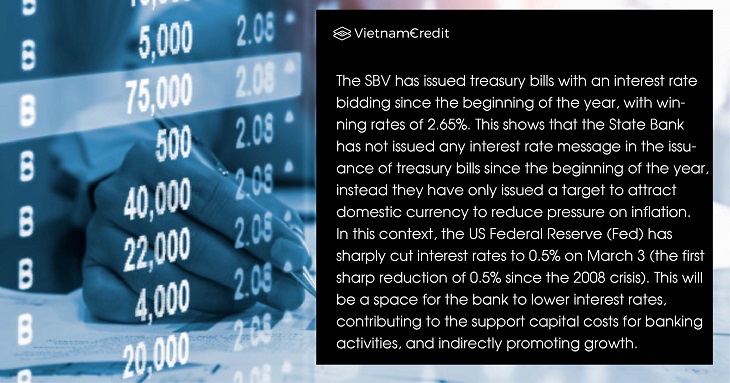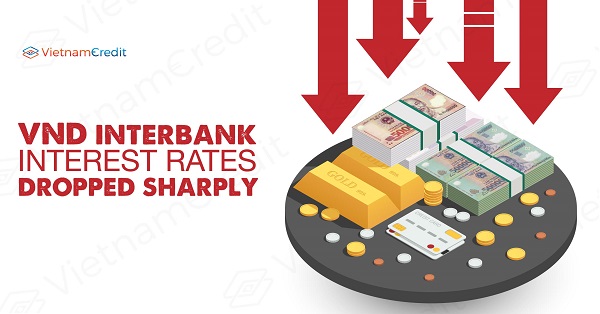Neither hastening monetary tightening nor being subjective with inflation is the message of the Governor of the State Bank of Vietnam (SBV) on monetary policy
A topic that has been discussed in recent times. While the epidemic is being improved in Vietnam, it is spreading strongly in several nations with major commercial cooperation with us, severely affecting the economy and the domestic inflation, forcing the monetary policy to be flexible to harmonize multiple goals this year, including both micro stability and growth support.
Monetary tightening is potentially unnecessary.
The General Statistics Office has just published the inflation index in February, according to which the average inflation in the first 2 months of 2020 has increased by 5.91% over the same period last year, reaching the highest peak in the last 7 years.
This may suggest that monetary tightening is currently crucial. However, the CPI in the first 2 months of the year is majorly controlled by the prices of restaurants and food services – which accounted for up to 36.12% in the commodity baskets for calculating CPI, with an increase of 10.12% over the same period last year. In which, the food group has increased by 0.32% compared to last month, and according to the GSO, this is the impact caused by the increased rice export price raising the domestic rice price by 0.34%.
The pharmaceutical and medical service sectors have also increased by 0.13% compared to that of January due to the effects of the Covid-19. It is also worth mentioning that the influences of the Covid-19 have increased the inflation of the expectation of the people.
Groups of people have stocked food, thus increasing the food prices after the Lunar New Year and decreasing the food prices in February by only 0.07% comparing to that in January. Generally, in the first 2 months of the year, the inflation was at a high level, mostly due to the Lunar New Year, together with the Covid-19 outbreak. However, the aforementioned factors may be reduced in the coming time as Vietnam declares the end of the outbreak in this country.
Inflation may gradually reduce in the coming time and the SBV may continue the net withdrawal of local currency before Tet to reduce pressure on inflation. In such a context, the overtightening of money (by increasing the interest rates and reducing the credit growth ceiling) may stop development and it seems that this is an unnecessary exchange.
The credit growth in the first 2 months of the year is decreasing compared to that of last year; meanwhile, tens of thousands of enterprises have dissolved and postponed business, thus the current needs for micro supporting policies are dire.
On February 24, the SBV sent a written request to credit institutions to propose three groups of measures to assist borrowers with losses due to the Covid-19 epidemic, including consideration of exemption and reduction of loan interest; maintaining the debt group; debt repayment structuring.
According to Bloomberg, the reduction or exemption of loan interest will affect about 11% of total current credit. However, these are appropriate measures to support the economy in the context that monetary policy is also under pressure from inflation.
Can the operating rates be lowered?
Although the CPI is expected to decline in the near future, with a high increase of 5.91% in the first 2 months of the year, inflation in the coming months will not be able to reduce rapidly to the target below 4%. Therefore, any interest rate lowering action needs to be carefully considered.
However, the operating interest rate basket includes many types of interest rates that have different effects on interest rates on financial markets and commercial interest rates; This includes a T-bills instrument tending to tighten with the role of absorbing excess domestic currency currently issued by the SBV daily with a term of 91 days.
The SBV has issued treasury bills with an interest rate bidding since the beginning of the year, with winning rates of 2.65%. This shows that the State Bank has not issued any interest rate message in the issuance of treasury bills since the beginning of the year, instead they have only issued a target to attract domestic currency to reduce pressure on inflation.
In this context, the US Federal Reserve (Fed) has sharply cut interest rates to 0.5% on March 3 (the first sharp reduction of 0.5% since the 2008 crisis). This will be a space for the bank to lower interest rates, contributing to the support capital costs for banking activities, and indirectly promoting growth.

Provided that the VND liquidity in the interbank market (LNH) continues to be abundant and the interest rate of LNH is maintained at a low level, the treasury bill interest rate will act as the floor interest rate, leading the interest rate of LNH.
Therefore, the State Bank should consider reissuing bills from 1 to 4 weeks and sending interest rate messages at these terms. Specifically, the SBV may call for 1-week treasury bills at 1.75-2% (down 0.25-0.5%) compared to the last one-week treasury bill issuance.
The terms of 2-4 weeks can issue interest rates of 0.25-0.75% higher than the 1-week terms. The re-issuance of treasury bills, on the one hand, helped the VND interest rates to decrease by a level compared to the current interest rates, saving capital costs for banks - who are trying to implement many measures to support businesses.
This also has an impact on the exchange rate by maintaining the correlation of US dollar and VND interest rates on LNH, avoiding a sharp drop in the exchange rate due to the impact of US dollar interest rate cuts, because the devaluation of the VND will benefit the trade balance at this time. We are having a trade deficit in the past 2 months and the current exchange rate is not high enough to force the VND interest rates to stay the same.
In addition, the SBV has been drawing a large number of treasury bills for 91 days (3 months) over the past time, so calling back these short terms has reduced the pressure on inflation, and also helped limit the disturbance of liquidity on LNH.
With the effective operation of the open market for many years, the repo interest rate (lending interest rate through the sale of valuable papers) is acting as the ceiling interest rate for the average lending interest rate of Vnibor, replacing discount rates and higher interest rates, along with bills interest rates, which function as the interest rate floor to create a mechanism of ceiling-correcting (corridor system) for LNH interest rates. With this mechanism, the State Bank of Vietnam may consider reducing the two interest rates at the same time.
As for the interest rate ceiling, lending is a very powerful tool affecting the commercial interest rates, and these sectors of applying the ceiling interest rate have many industries in the group affected by Covid-19, typically as exporting enterprises.
Therefore, reducing the ceiling interest rate will have immediate impacts on the right people and the right places that require support. However, it is still necessary to pay attention to the reduction of interest rates on tools that tend to increase the money supply and increase credit such as ceiling lending rates, repo interest rates, because inflation in the first 2 months of the year was still high.
Therefore, there is probably no need to reduce these rates and instead, growth-enhancing measures may be pushed through fiscal. In the context of the low public investment (in February, it only disbursed 7.4 trillion VND, equal to only 1.6% of the plan), the continuous budget surplus that cannot improve growth is clearly wasting huge resources in the economy. The recent increasing subsidies on medical services and or the stimulus packages for households and businesses affected by the disease can be applied. If lowering interest rates is an instrument of easing but the money is withdrawn from circulation (treasury bill issuance), the instrument has a tightening value.
Therefore, it can be said that Vietnam's monetary policy is flexible in using tools. Moreover, the message of tightening or loosening will also have a psychological impact on the financial markets and the expectations of people and businesses and sometimes will confuse the public opinion.
Speaking at the meeting of the Finance and Monetary Policy Advisory Council on February 25th, the Governor of the State Bank also said that the macro stability would ensure a solid foundation for future growth. In fact, macroeconomic stability has played an important role in attracting foreign investment and it is these capital flows that have been the main drivers of Vietnam's growth in recent years.
Moreover, foreign capital inflows have also helped Vietnam to have more foreign exchange reserves and, in turn, stabilized the macro. Therefore, monetary policy should be flexible instead of obvious tightening or easing, to ensure the above objective.
>> What will the bank interest rates in 2020 be like?
Source: https://www.thesaigontimes.vn/
























































